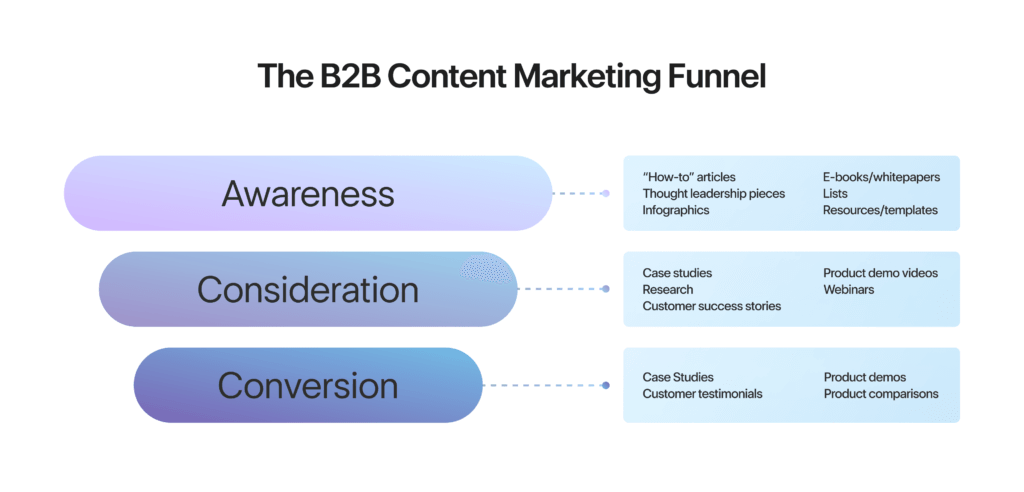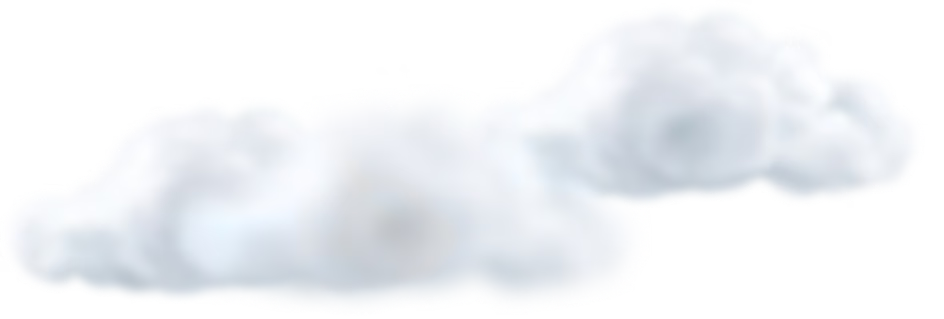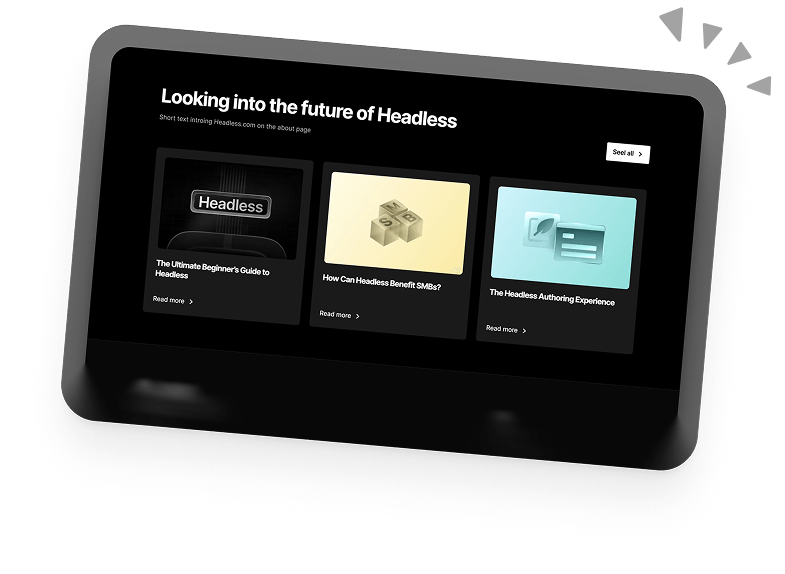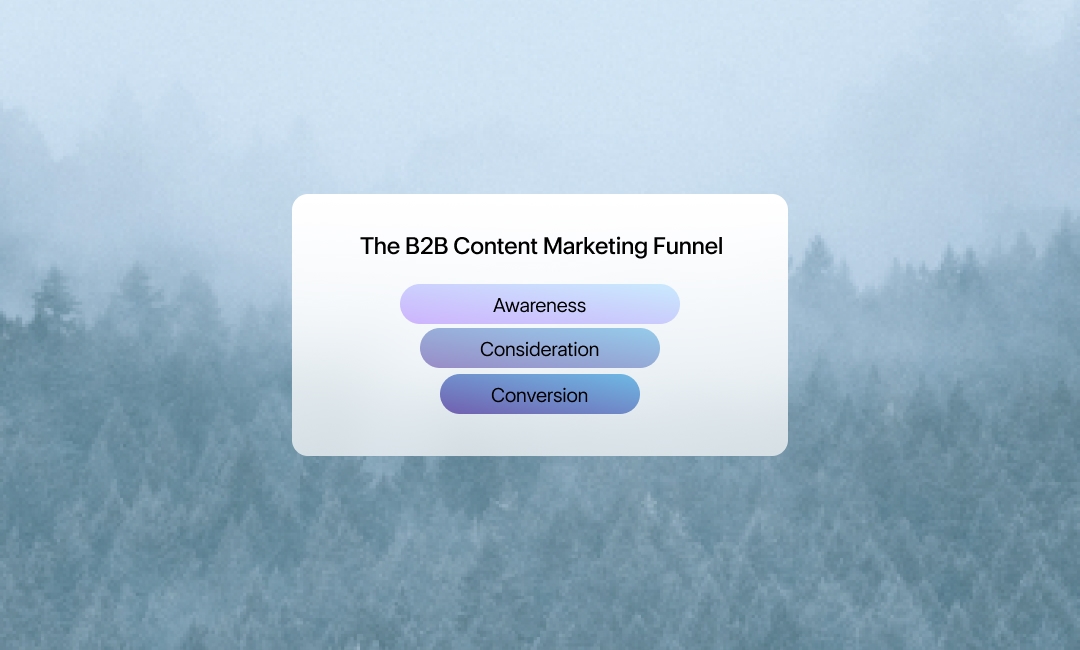The B2B Content Marketing Funnel: How To Optimise Your Content Strategy
One of the most important aspects of your B2B content marketing strategy, is ensuring that your content is carefully aligned with your marketing funnel.
Optimising your content marketing strategy is fundamental to your overall business success as it majorly impacts the buyers’ decision-making process. According to a report by the CMO Council, 87% of B2B buyers said that online content had a significant impact on vendor selection.
In this article, we’ll look at the B2B Content Marketing Funnel and how it should inform your content strategy.

But first let’s answer the question…
How does the B2B Marketing Funnel differ from the B2C Marketing Funnel?
The B2B and B2C content marketing funnels may appear the same at first glance, but they have some fundamental differences.
Decision-making process: In B2B, the decision-making process is longer and involves multiple decision-makers, while in B2C, the decision-making process is shorter and involves fewer decision-makers.
Content types: The content types used in the B2B funnel are more focused on providing in-depth information and building trust with potential clients, while the B2C funnel typically focuses on emotional responses.
Purchase cycle: In B2B, the purchase cycle is longer, with more emphasis on establishing a long-term relationship with potential clients. In B2C, the purchase cycle is shorter and more focused on immediate gratification.
Now, with that out of the way, it’s time to look at the stages of the B2B Content Marketing Funnel.
The Awareness Stage
At this stage your content is designed to attract traffic and increase awareness of your brand.
This will usually be more general and educational content related to your niche but not directly about your company. The goal with this content is to simply get your brand out there and get it recognised.
Potential customers at this stage need to “warm up” to you, so this is all about providing them with a great customer experience.
Content at this stage of the funnel can include:
- “How-to” articles
- Thought leadership pieces
- Infographics
- E-books/whitepapers
- Lists
- Resources/templates
One of the biggest factors that will move a B2B buyer through the marketing funnel is authority. Content marketing has a lot of potential to establish you as being an authoritative source in your niche.
What you’re doing here is providing them with free value. But at the same time you’re planting seeds of trust. You see, B2B buyers place a lot more value on the credibility of a company. They’re looking to form long-term partnerships and sizeable investments rather than one-off purchases. That’s why the B2B sales journey can take months and even a whole year.
The Consideration Stage
This is the part where people move from simple visitors to leads.
In this stage of the marketing funnel, your content should adapt to have more focus on your products/services. The goal here is twofold: you want to educate them about your products while also gently persuading them of your value proposition.
Content in the consideration stage of the funnel can include:
- Case studies
- Research
- Customer success stories
- Product demo videos
- Webinars
There is also, inevitably, some overlap between the funnel stages. For example, you may still produce educational content (such as research) but the focus has shifted somewhat towards your company. Content marketing aimed at this stage of the funnel will correlate more directly towards your services, including Calls To Action towards services pages, email signups, and contact pages.
However, it’s important to strike a balance between educating your audience and promoting your brand. According to the Content Marketing Institute, 87% of the top performers in B2B content marketing said they prioritise the audience’s educational needs over the brand’s promotional messaging.
The whole marketing funnel, especially in the context of content marketing, is a lot like storytelling.
You can think of the “Awareness” stage as “setting the scene”. You’re providing an overview of your industry and the issues within it. Now, in the “Consideration” phase, you are introducing the main character (you). Based on what this character does and says next, the audience will decide whether or not they trust/like them.
These 2 stages, awareness and consideration, are the longest in the B2B Marketing Funnel. For a new customer, the average sales cycle takes around 4-6 months and, of that time, they will spend only 17% meeting with suppliers, compared to 27% researching online.
The Conversion Stage
Here it is: the stage you’ve all been waiting for! This is where you make your move.
The potential client knows who you are and what you offer. But why choose your service specifically? How will you make it worth their while? And how do you differentiate yourself from the competition?
Content at this final stage can be the deciding factor in closing a sale.
Here, your content will focus on your products and services, providing detailed information about them and addressing any potential concerns that your customers may have.
Content in the conversion stage of the B2B Marketing Funnel includes:
- Case Studies
- Customer testimonials
- Product demos
- Product comparisons
This is where you need to go all out on promoting your services. However, it’s crucial that your content remain user-focused, even at this stage. When discussing your products, remember to focus on what the customer wants to know. Prioritising customers’ concerns will always get their attention but you may lose their interest if you fall into the trap of simply bragging about features.
Conclusion
Mapping your content strategy to your marketing funnel will drastically increase the effectiveness of your content marketing. The most important thing is to remain user-focused, thinking of content as part of your overall user experience strategy.
Book a 30-min Introduction Call
Let's jump on a quick intro call We'll break down your project, and pinpoint exactly how we can help.



Our clients  Holaa! love working with us see their stories below!
Holaa! love working with us see their stories below!






